
Lakeville is a town in Plymouth County, Massachusetts, United States. The population was 11,523 at the 2020 census.
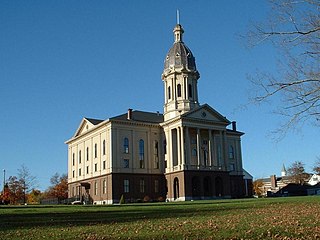
Middleborough is a town in Plymouth County, Massachusetts, United States. The population was 24,245 at the 2020 census. The census-designated place of Middleborough Center corresponds to the main village and commercial center of the town. It is the second largest municipality by land area in Massachusetts and nineteenth largest in New England. Middleborough proclaims itself to be the "Cranberry Capital of the World". Cranberry production remains a significant part of the local economy. In 2015, approximately 1,400 acres of the town were used to grow the crop, accounting for 3% of all land used to harvest cranberry bogs in the United States.

The Taunton River, historically also called the Taunton Great River, is a river in southeastern Massachusetts in the United States. It arises from the confluence of the Town River and Matfield River, in the town of Bridgewater. From there it meanders through the towns of Halifax, Middleborough and Raynham, through the city of Taunton for which it is named, the towns of Berkley, Dighton, Somerset, and the Assonet section of Freetown, to Fall River where it joins Mount Hope Bay, an arm of Narragansett Bay.

Lake Sabbatia, sometimes known as Scaddings Pond is a 248-acre great pond in Taunton, Massachusetts, near Watson Pond State Park. The lake is where Mill River begins and the Snake River ends. It is the largest lake in the city of Taunton and the most popularly used. There are several coves and an island within the lake. Parts of its coastline are populated with woods, streets, and residential homes. Lake Sabbatia is used for a variety of recreational activities such as boating, swimming, fishing, and ice fishing. There is a boat ramp off Bay Street into the lake.
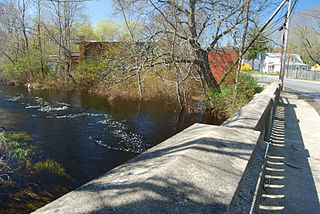
The Nemasket or Namasket River is a small river in southeastern Massachusetts. It flows north 11.2 miles (18.0 km) from Assawompset Pond in Lakeville and through Middleborough where it empties into the Taunton River. The Nemasket's sole tributary is Fall Brook, which drains out from Tispaquin Pond.
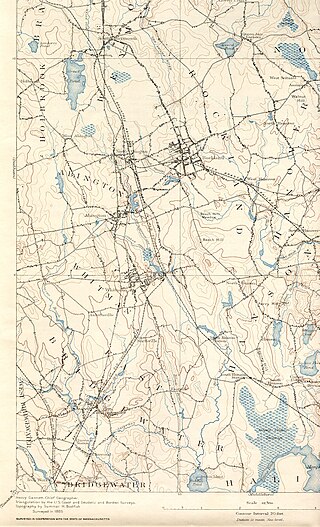
The Satucket River is 5.5-mile-long (8.9 km) river in southeastern Massachusetts within the Taunton River Watershed. It flows generally west from Robbins Pond in East Bridgewater, and into the Matfield River.
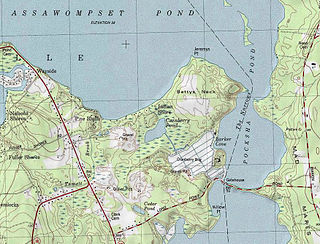
Pocksha Pond is a lake/reservoir/pond within the towns of Lakeville and Middleboro, in southeastern Massachusetts. It shares its waters with Great Quittacas Pond and openly connected with Assawompset Pond. These lakes provides a source of drinking water to the city of New Bedford, the largest city in southeastern Massachusetts.

Great Quittacas Pond is a lake, reservoir, or pond within the towns of Lakeville, Middleboro, and Rochester, in southeastern Massachusetts. It shares its waters with Pocksha Pond and possibly nearby Little Quittacas Pond. These lakes provide a source of drinking water to the city of New Bedford, the largest city in southeastern Massachusetts.

Little Quittacas Pond is a lake/reservoir/pond within the towns of Lakeville and Rochester, in southeastern Massachusetts. Little Quittacas is one of the five great ponds of Southeastern Massachusetts that includes Long Pond, Assawompset Pond. Pocksha Pond, Great Quittacas and Little Quittacas Ponds. It is the location of the New Bedford Water Works. These lakes provide a source of drinking water to the city of New Bedford, the largest city in southeastern Massachusetts. Snipatuit Pond is an outlier pond that flows into Buzzards Bay, via the Mattapoisett River and is connected to Great Quittacas through Snipituit Brook. The other great ponds drain into Narragansett Bay through the Taunton River. The five ponds are the largest natural fresh watersheds in Massachusetts.

Long Pond is a 1,721-acre (7.0 km2) lake within the towns of Lakeville and Freetown, in southeastern Massachusetts. It shares its waters with Assawompset Pond. These lakes provide a source of drinking water to the city of New Bedford, the largest city in southeastern Massachusetts. Long Pond is roughly one mile (1.6 km) wide by four miles (6.4 km) miles long, and contains three islands within its boundaries. In 1894 Assawompset Pond was dammed, increasing the water depth of Long Pond by about five feet (1.5 m). This created Nelson Island and caused Sunken Island to disappear due to erosion. All that remains of Sunken Island are the rocks in a shallow area just to the northwest of Lewis Island. Lewis Island is the largest of the three remaining islands today, containing sixteen privately owned cottages, while the second largest island, Nelson Island, was purchased in 2005 and now is a year-round private residence. The smallest island, Goat Island, was recently purchased from the Boy Scouts by a private citizen. Along the perimeter of the lake are many homes and private access points to the waterfront. Long Pond is well known for fishing and boating.

The Powwow River is a 22.8-mile-long (36.7 km) river located in New Hampshire and Massachusetts in the United States. It is a tributary of the Merrimack River, part of the Gulf of Maine watershed.

Powwow Pond is a 348-acre (1.41 km2) water body in Rockingham County in southeastern New Hampshire, United States. It is classified as an artificial impoundment. The outlet of the pond is located in the town of East Kingston, but most of the lake lies in the town of Kingston. The Powwow River, the outlet of the pond, flows to the Merrimack River in Amesbury, Massachusetts.

Route 105 is a 29.36-mile-long (47.25 km) state highway in southeastern Massachusetts, running from Marion to Halifax in a generally north-south direction. Its southern terminus is at U.S. Route 6 in Marion and its northern terminus is at Route 106 in Halifax. Along the way it intersects Interstate 195 (I-195) in Marion and Interstate 495 and US 44 in Middleborough.

Winnecunnet Pond or Winneconnet Pond or Winnecunnett Pond, very often called Lake Winnecunnet or Lake Winneconnet or Lake Winnecunnett although it is a pond rather than a lake, is a body of water in Norton, Massachusetts, United States.
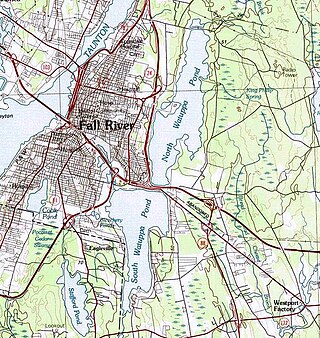
The Watuppa Ponds are two large, naturally occurring, spring-fed, glacially formed ponds located in Fall River and Westport, Massachusetts. Watuppa is a native word meaning "place of boats". The two ponds were originally one body of water, connected by a narrow rocky straight called "The Narrows" located on a thin strip of land between the two ponds which forms part boundary of between Fall River and Westport. The border between Fall River and Westport is also divided between the two ponds. Together, the ponds have an overall north–south length of about 7.5 miles, and have an average east–west width of about a mile. The ponds are drained by the Quequechan River, and flows in a westerly direction through the center of Fall River from South Watuppa Pond to Mount Hope Bay.

Houghton's Pond is a spring-fed kettle hole pond in Milton, Massachusetts, south of Boston. Like many ponds and lakes in the United States, it was formed by receding glaciers about 10,000 years ago. By the standard definition of lakes being bodies of water larger than 20 acres (8.1 ha), the 24-acre (9.7 ha) pond is technically a lake.

A pond is a small, still, land-based body of water formed by pooling inside a depression, either naturally or artificially. A pond is smaller than a lake and there are no official criteria distinguishing the two, although defining a pond to be less than 5 hectares in area, less than 5 metres (16 ft) in depth and with less than 30% with emergent vegetation helps in distinguishing the ecology of ponds from those of lakes and wetlands. Ponds can be created by a wide variety of natural processes, or they can simply be isolated depressions filled by runoff, groundwater, or precipitation, or all three of these. They can be further divided into four zones: vegetation zone, open water, bottom mud and surface film. The size and depth of ponds often varies greatly with the time of year; many ponds are produced by spring flooding from rivers. Ponds may be freshwater or brackish in nature. 'Ponds' consisting of saltwater, with a direct connection to the sea to maintain full salinity, are normally regarded as part of the marine environment. These bodies of water do not support fresh or brackish water-based organisms, and are not considered to be ponds.





















